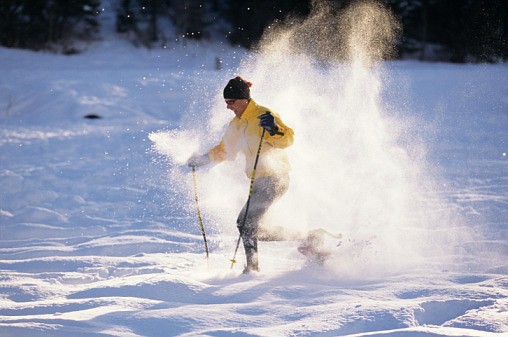Snowshoeing: The ideal winter sport for all ages
December 15, 2011 at 6:00 a.m.
Snowshoeing is recognized as one of the oldest methods of transportation, and it's increasing in popularity today. It is a sport that requires very little training, because anyone who knows how to walk can snowshoe. Further, there's not a large equipment investment that's necessary in order to get started; all you'll need to acquire is snowshoes, and they can be rented cheaply or purchased for a reasonable price. To really understand why snowshoeing is so popular today, consider everything this sport has to offer.
From a health aspect, snowshoeing is appreciated for its physiological benefits. Commonly utilized as a cross-training exercise, snowshoeing can improve cardiovascular performance and strengthen your legs and upper body. It is a low-impact sport that people of all ages can enjoy safely, making it an ideal family activity. If you're turning to snowshoeing for exercise, the intensity of your workout will vary based on the terrain, and you can burn as many as two times the calories you would walking at the same pace. According to research on the subject, snowshoeing works all of the major muscles and, despite its low-impact status, burns as many as 1000 calories per hour. What sets snowshoeing apart from the crowd is the resistance afforded by the snow as you walk, as well as the increase in your metabolism due to the cold.
If you think you can walk well in clown shoes, then you will be good at snowshoeing. Perhaps the most difficult part about it is learning how to traverse hills. Instead of trying to walk in a straight line, step in a zigzag fashion, and use your polls to help steady yourself as you climb upward. When heading downhill, use the crampon on the back of the snowshoe, which resembles a claw, to dig into the snow. This will help you to get your footing as you slowly creep down the hill using your poles to steady your decent.
Snowshoeing is also good for your mental well-being. Being outside in nature in the winter gives you a peace of mind that's hard to find anywhere else. The world looks different with a fresh covering of snow, and all that's really necessary to snowshoe is a couple of inches of the white stuff. You can also incorporate other hobbies into your snowshoeing expeditions, and take the time to identify plants, trees, animal tracks and birds. You might even come across some wildlife on your way, since snowshoeing is generally a quiet sport in which the only sound that's made is the soft crunch of snow beneath your feet.
Now that you know that snowshoeing is a sport that's safe, fun and beneficial for people of all ages, you're probably curious where you can go to christen your snowshoes. You might consider traveling to one of the many state and national parks scattered across the country, many of which are ideally suited to snowshoeing and winter hiking. Some of the most popular snowshoeing trails are located on either end of the country. To the west, popular locations include Cub Lake, Copeland Falls and Lily Pad Lake in Colorado and Artist Point, Camp Muir and Rampart Ridge in Washington. On the east coast, locations such as Mount Willard Trail in New Hampshire, Douglas Mountain in Maine and Spruce Trail Hill in Massachusetts are all favored by snowshoeing aficionados. Without working too hard, you'll probably be able to find a location right in your own backyard, town or county that will provide you with flat terrain and beautiful views for your first outing.
Content Provided by Spot55.com





